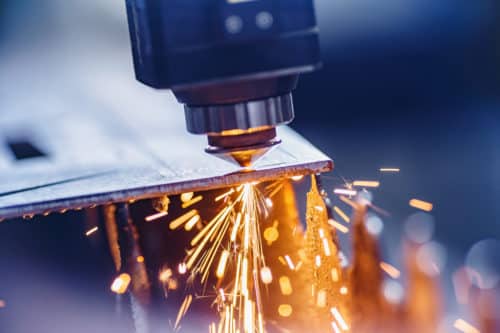Lasers come in a wide array of types and strengths, producing extremely accurate cuts that facilitate the creation of intricate shapes. This thermal cutting process is favored for a variety of applications and particularly useful with soft and mild metals that are prone to excess damage from more traditional cutting tools. Lasers can cut through mild steel, stainless steels and aluminum with only a small kerf without otherwise damaging the remaining material.
This article will describe the laser cutting process and how it works.
What is a Laser?
Though the full term is rarely used anymore, the word “LASER” is an acronym for Light Amplification by Stimulated Emission of Radiation. This form of light doesn’t exist in nature and was artificially created to harness the unique properties of light in a controllable device. Lasers vary in light type, intensity, and diameter to facilitate uses across a wide variety of recreational, commercial, and industrial applications.
Each laser beam is a collection of light beams with identical or nearly identical wavelengths. The waves are in phase, which means they travel uniformly with the peaks of each wave occurring in sync. This manipulation of the light waves gives a laser its signature brightness and narrow focus. This focus produces very uniform light that will travel long distances. Laser beams also concentrate energy, or power, into a small surface area.
The Laser Cutting Process
Concentrated energy is the core premise of laser cutting. Laser cutting machines generate a ¾-inch wide laser beam. This beam is pushed through a nozzle, which contains compressed oxygen, nitrogen, or another gas, and potentially through beam bender mirrors.
Laser cutting machines use precise setups to focus the beam within the laser cutting head. First, a curved mirror or lens concentrates the light into a single point. At this point, the light is concentrated, small, and produces significant heat. The laser cutting head’s focus concentrates the laser beam until it’s strong enough to melt through metal. It heats, melts, and vaporizes the material along its cut path.
The process may differ depending on the type of metal being cut:
- Mild steel cutting uses pure oxygen in the nozzle bore. The laser’s heat triggers an oxy-fuel burn with pure oxygen.
- Aluminum or stainless steel cutting uses pure nitrogen in the nozzle bore. The laser handles all the burning and cutting, while the nitrogen blows the kerf free of molten metal remains.
Laser cutters carefully orient the laser cutting head to facilitate the melting and cutting action. If the focal point is even slightly too low or too high, it can alter the quality of the cut. Precision aiming is facilitated using a capacitive height control system. The cutting head follows programmed instructions to create specific cuts and holes according to design specifications.
Materials for Laser Cutting
Lasers can etch and cut through many different materials. At G.E. Mathis Company, we work with the following materials:
- Aluminum
- Carbon steel
- High-strength steel
- Abrasion Resistant Steel
- Stainless steel
G.E. Mathis Company Precision Laser Cutting
G.E. Mathis Company specializes in high-quality laser cutting and etching for prototype, low-volume, and high-volume orders. Our advanced equipment and skilled laser technicians can handle a broad range of materials, product dimensions, material thicknesses, and order volumes. Our standard thickness capabilities range from 16-gauge sheet metal to steel plates 1-1/4 inches thick.
In addition to being an ISO 9001:2015-certified manufacturer, G.E. Mathis Company can provide the following services:
- PPAP (Production Part Approval Process) – All Levels
- FAIR (First Article Inspection Report)
- Capability Studies (Statistical Process Control)
- CMRT (Conflict Minerals Reporting Template)
To see how our laser cutting capabilities can serve your project, please contact us or request a quote.















